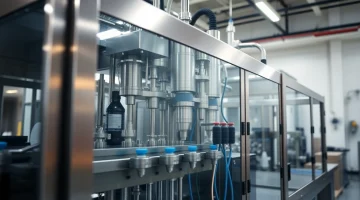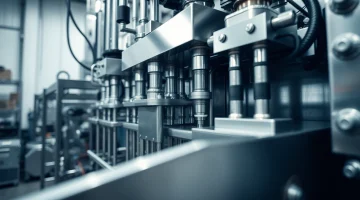
The Essential Guide to Machine Vision: Applications and Technologies
Understanding Machine Vision
With the rapid advancement of technology, industries are harnessing state-of-the-art tools to enhance efficiency and accuracy. One such powerful tool is machine vision, which incorporates computer algorithms to help machines interpret visual data in real-time. This technology is not just a matter of seeing but involves a comprehensive system to analyze images, detect defects, and make informed decisions—revolutionizing sectors from manufacturing to healthcare.
What is Machine Vision?
Machine vision refers to the ability of a computer system to interpret and understand visual information from the world, leveraging imaging technology. It encompasses the acquisition of images, processing the captured data, and executing tasks based on this interpretation. Unlike human vision, which is deeply influenced by perception and context, machine vision relies on pre-programmed algorithms and artificial intelligence to carry out specific functions.
The Role of Cameras and Sensors
Cameras are the centerpiece of machine vision systems, capturing images that provide the raw data for analysis. Various types of cameras can be utilized, ranging from standard visible light cameras to specialized devices like infrared or color cameras. Coupled with sensors, these cameras can provide vital information about products on an assembly line, detect anomalies, or even assess the integrity of components. The choice of camera and sensor significantly impacts the quality and reliability of the image data captured, making it crucial to select the appropriate technology for specific applications.
Comparison: Machine Vision vs. Computer Vision
Although the terms ‘machine vision’ and ‘computer vision’ are often used interchangeably, it’s essential to understand their differences. Machine vision is primarily focused on using visual data for specific applications, mainly in industrial settings, where the goal is often automation and defect detection. On the other hand, computer vision encompasses a broader scope, including the development of algorithms that allow machines to interpret visual data from everyday environments, supporting applications like facial recognition and autonomous navigation.
Applications of Machine Vision
Machine vision technology has found its place across various fields due to its flexibility and effectiveness. Below, we explore some of the critical applications of machine vision in contemporary settings.
Quality Control in Manufacturing
One of the most prominent applications of machine vision is in quality control during manufacturing processes. The ability to consistently monitor products as they move through production lines ensures that only those meeting specific standards proceed to the next step. For instance, in the automotive industry, machine vision systems can identify defects such as scratches or dents on vehicle surfaces before assembly, reducing costly recalls.
Furthermore, real-time data captured through machine vision allows manufacturers to maintain detailed records of quality inspections, enabling better decision-making and improvements in the production process.
Automation in Warehousing
With the rise of e-commerce, warehousing operations have seen intensified demands for speed and accuracy. Machine vision facilitates automation by allowing systems to identify, categorize, and sort items efficiently. For example, optical barcode scanners, powered by machine vision, enable rapid processing of goods as they arrive in warehouses, reducing manual errors and significantly speeding up inventory management.
Moreover, advanced robotics equipped with machine vision capabilities can navigate complex warehouse layouts, perform tasks like picking and packing with precision, enhancing overall operational efficiency.
Healthcare Uses and Innovations
In the healthcare sector, machine vision technology plays an essential role in diagnostics and surgical assistance. High-resolution imaging systems are utilized in radiology to analyze medical images and detect anomalies, such as tumors or fractures. Applications extend to robotic-assisted surgeries, where machine vision systems guide surgical tools with precision, improving patient outcomes while reducing recovery times.
Additionally, machine vision can aid in clinical laboratories by automating the image analysis process, allowing for quicker diagnoses and more accurate patient data management.
Components of Machine Vision Systems
A machine vision system is composed of various components that work together to capture and interpret visual information. Understanding these components is vital for anyone looking to implement machine vision into their operations.
Cameras and Optical Systems
Cameras form the backbone of machine vision systems. Depending on the application, different camera types can be employed, such as CCD (Charge-Coupled Device) or CMOS (Complementary Metal-Oxide-Semiconductor) cameras. Optical systems, including lenses and filters, also significantly influence image quality. High-quality lenses ensure that cameras capture clear, sharp images, while specialized filters can enhance specific wavelengths of light, improving analysis accuracy.
Lighting Techniques for Optimal Imaging
Lighting plays a crucial role in machine vision systems, as poorly lit images can lead to inaccurate analyses. Various lighting techniques may be employed, including backlighting, sidelighting, or diffuse lighting to emphasize relevant features in the image. For instance, backlighting can be beneficial for detecting edges or contours, while diffuse lighting minimizes shadows and allows for a more uniform illumination of surfaces. Engineers must design appropriate lighting setups specific to the tasks at hand to maximize data capture quality.
Processing Hardware and Software Algorithms
After images are captured, they require processing to yield useful insights. The processing component involves dedicated hardware, such as GPUs (Graphics Processing Units) or FPGAs (Field Programmable Gate Arrays), which optimize computational speed for complex analyses. Software algorithms, including machine learning techniques, enhance a system’s ability to analyze datasets, detect patterns, and apply classification. The integration of robust processing hardware with efficient algorithms determines a machine vision system’s performance and reliability.
Implementing a Machine Vision Solution
The path to successfully implementing a machine vision solution requires careful planning and execution. Here are the critical steps and considerations involved in this process.
Steps for System Integration
- Define the Application Goals: Begin by clearly delineating what you wish to achieve with machine vision. Whether it’s quality assurance, product sorting, or defect detection, understanding objectives will guide your choices.
- Select Appropriate Components: Based on your application goals, choose cameras, sensors, lighting, and software tools suited to your specific environment and tasks.
- Install and Calibrate Systems: Carefully install the chosen components and calibrate them to work together seamlessly. Calibration ensures that all elements are aligned and operational, fine-tuning the setup for robustness.
- Testing and Validation: Conduct trials to validate the system’s functionality and performance, ensuring effectiveness in fulfilling the intended application goals.
- Continuous Monitoring and Optimization: Once implemented, consistently monitor system performance and seek opportunities for improvements based on evolving needs and technological advancements.
Common Challenges and Solutions
While implementing machine vision solutions can yield significant benefits, several challenges may arise:
- Image Quality Issues: Poor image quality can hamper analysis. To address this, invest in high-quality cameras and optimize lighting conditions.
- System Integration Difficulties: Compatibility issues between hardware and software components may occur. Confirm that all selected components are designed to work in conjunction with one another.
- High Initial Costs: The upfront investment in machine vision technology can be substantial. Balance this by evaluating the long-term savings and efficiency gains that machine vision can facilitate.
Performance Metrics to Consider
To measure the effectiveness of a machine vision system accurately, it’s essential to track several performance metrics, including:
- Image Processing Speed: The time taken to capture and analyze images should be minimized to ensure real-time applications.
- Accuracy and Precision: Evaluate the percentage of correct detections and classifications against total instances to assess reliability.
- System Uptime: Ensure minimal disruptions in operations due to downtime, as high uptime is a desirable outcome for any automation process.
Future Trends in Machine Vision
As technology continues to evolve, so will the capabilities and applications of machine vision. Understanding these future trends is vital for organizations looking to remain competitive.
Advancements in Artificial Intelligence
The integration of artificial intelligence (AI) into machine vision systems is set to transform the landscape dramatically. AI algorithms can enhance the capability of these systems, enabling them to learn from data patterns and adapt over time. For instance, deep learning methods allow for improved object recognition and classification, even in complex environments.
As AI technology matures, the potential for autonomous decision-making through machine vision will increase, leading to more sophisticated applications across various industries.
Market Growth and Industry Forecasts
The machine vision industry is poised for substantial growth, with projections reflecting a multibillion-dollar global market by the end of the decade. Various sectors, including manufacturing, logistics, healthcare, and automotive, are expected to fuel demand due to the increasing need for automation and quality assurance processes.
Investments in machine vision technology can lead to substantial efficiency improvements, making it a focal point for companies looking to upgrade their operations.
The Impact of Machine Vision on Automation
As machine vision continues to integrate with robotics and AI, its impact on automation will be profound. The ability for systems to interpret and act upon visual information in real-time paves the way for greater automation in industries ranging from production lines to grocery stores. This shift toward automation promises increased efficiency, cost savings, and enhanced product quality, representing a significant transformation in operational paradigms.



